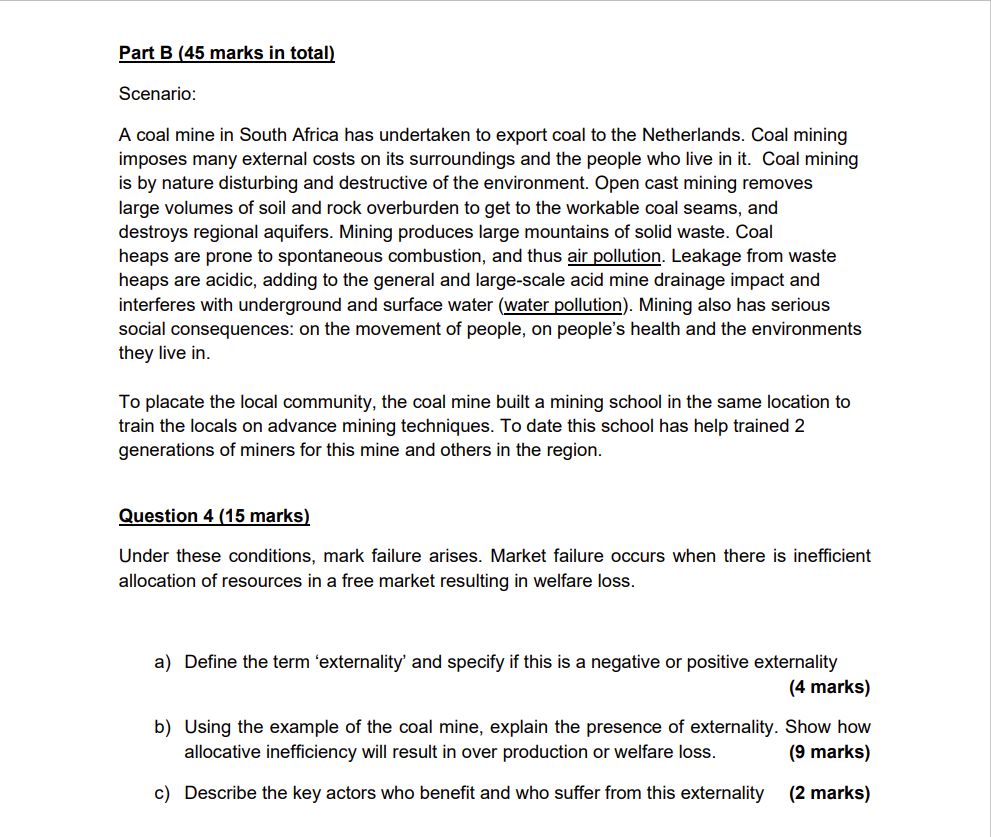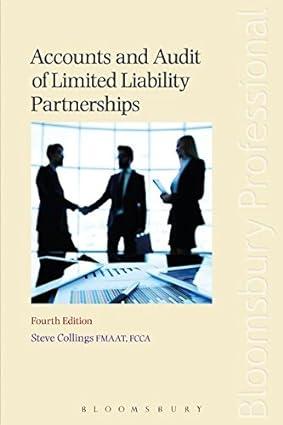

Scenario: A coal mine in South Africa has undertaken to export coal to the Netherlands. Coal mining imposes many external costs on its surroundings and the people who live in it. Coal mining is by nature disturbing and destructive of the environment. Open cast mining removes large volumes of soil and rock overburden to get to the workable coal seams, and destroys regional aquifers. Mining produces large mountains of solid waste. Coal heaps are prone to spontaneous combustion, and thus air pollution. Leakage from waste heaps are acidic, adding to the general and large-scale acid mine drainage impact and interferes with underground and surface water (water pollution). Mining also has serious social consequences: on the movement of people, on people's health and the environments they live in. To placate the local community, the coal mine built a mining school in the same location to train the locals on advance mining techniques. To date this school has help trained 2 generations of miners for this mine and others in the region. Question 4 (15 marks) Under these conditions, mark failure arises. Market failure occurs when there is inefficient allocation of resources in a free market resulting in welfare loss. a) Define the term 'externality' and specify if this is a negative or positive externality (4 marks) b) Using the example of the coal mine, explain the presence of externality. Show how allocative inefficiency will result in over production or welfare loss. (9 marks) c) Describe the key actors who benefit and who suffer from this externality (2 marks) Thinking about the water pollution caused by the coal mine. a) Specify if this is a point or non-point pollution source (2marks) b) Draw and correctly label a diagram to demonstrate how you would determine the optimal level of pollution in the river based on trading off the damage caused by the pollution and the pollution abatement costs (8 marks) c) Explain how government intervention such as the imposition of taxation may reduce the coal production to socially optimal level. State whether this policy is a command and control or market-based policy. (5 marks) d) Evaluate the policy of taxation in reducing the level of coal-mining to socially optimal levels. (5 marks) e) Are there command and control policy/policies available to government to solve this problem of pollution? Elaborate on this method. Explain their key strengths and weaknesses. (10 marks) Scenario: A coal mine in South Africa has undertaken to export coal to the Netherlands. Coal mining imposes many external costs on its surroundings and the people who live in it. Coal mining is by nature disturbing and destructive of the environment. Open cast mining removes large volumes of soil and rock overburden to get to the workable coal seams, and destroys regional aquifers. Mining produces large mountains of solid waste. Coal heaps are prone to spontaneous combustion, and thus air pollution. Leakage from waste heaps are acidic, adding to the general and large-scale acid mine drainage impact and interferes with underground and surface water (water pollution). Mining also has serious social consequences: on the movement of people, on people's health and the environments they live in. To placate the local community, the coal mine built a mining school in the same location to train the locals on advance mining techniques. To date this school has help trained 2 generations of miners for this mine and others in the region. Question 4 (15 marks) Under these conditions, mark failure arises. Market failure occurs when there is inefficient allocation of resources in a free market resulting in welfare loss. a) Define the term 'externality' and specify if this is a negative or positive externality (4 marks) b) Using the example of the coal mine, explain the presence of externality. Show how allocative inefficiency will result in over production or welfare loss. (9 marks) c) Describe the key actors who benefit and who suffer from this externality (2 marks) Thinking about the water pollution caused by the coal mine. a) Specify if this is a point or non-point pollution source (2marks) b) Draw and correctly label a diagram to demonstrate how you would determine the optimal level of pollution in the river based on trading off the damage caused by the pollution and the pollution abatement costs (8 marks) c) Explain how government intervention such as the imposition of taxation may reduce the coal production to socially optimal level. State whether this policy is a command and control or market-based policy. (5 marks) d) Evaluate the policy of taxation in reducing the level of coal-mining to socially optimal levels. (5 marks) e) Are there command and control policy/policies available to government to solve this problem of pollution? Elaborate on this method. Explain their key strengths and weaknesses. (10 marks)








